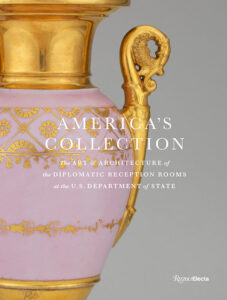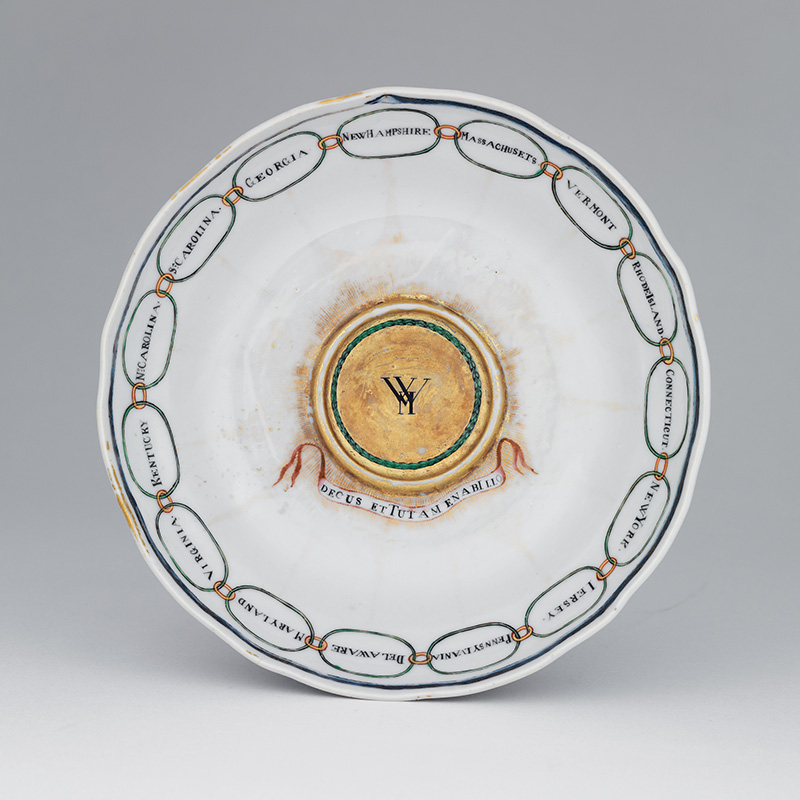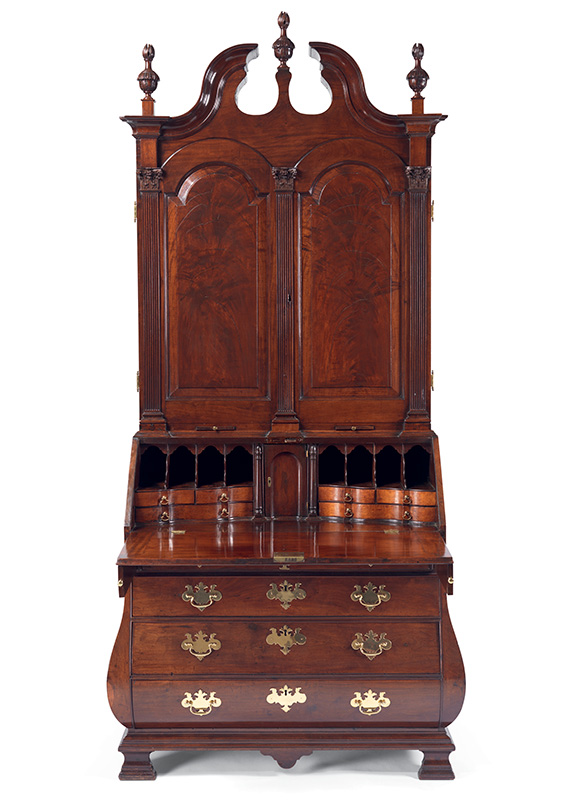Setting the Scene for Diplomacy: New Book on the Department of State’s Reception Rooms
 A stunning new publication graced our desks at the Decorative Arts Trust, and we would be remiss if we do not share some highlights from this illuminating volume. America’s Collection: The Art and Architecture of the Diplomatic Reception Rooms at the U.S. Department of State (Rizzoli Electa, 2023) surveys the spaces that have hosted political negotiations for six decades. Tucked inside Washington, D.C.’s Truman Building sits a collection of more than 5,000 objects, including paintings by John Singleton Copley and Gilbert Stuart, silver and porcelain owned by George Washington and other presidents, and fine furniture such as the desk on which the treaty that ended the Revolutionary War was signed.
A stunning new publication graced our desks at the Decorative Arts Trust, and we would be remiss if we do not share some highlights from this illuminating volume. America’s Collection: The Art and Architecture of the Diplomatic Reception Rooms at the U.S. Department of State (Rizzoli Electa, 2023) surveys the spaces that have hosted political negotiations for six decades. Tucked inside Washington, D.C.’s Truman Building sits a collection of more than 5,000 objects, including paintings by John Singleton Copley and Gilbert Stuart, silver and porcelain owned by George Washington and other presidents, and fine furniture such as the desk on which the treaty that ended the Revolutionary War was signed.
Virginia B. Hart, the director and curator of the Diplomatic Reception Rooms, assembled a stellar cadre of scholars for this publication. Following an introduction by former United States Secretary of State John F. Kerry are chapters by Stacy Schiff, Carolyn Vaughan, Bri Brophy, Allan Greenberg and Mark Alan Hewitt, Laaren Brown, Elizabeth Mankin Kornhauser, Alice Cooney Felinghuysen, Alexandria Alevizatos Kirtley, Elliot Bostwick Davis, and Deborah Dependahl Waters. An afterword by David M. Rubenstein concludes the story.
In her chapter “Ceramics: Foreign Wares to American Shores,” Alice (Nonnie) Cooney Frelinghuysen, the Metropolitan Museum of Art’s Anthony W. and Lulu C. Wang Curator of American Decorative Arts, spotlights the interconnectedness of the collection’s array of Chinese export porcelain for the expanding merchant class and outstanding examples from the Atlantic trade between the new United States and Europe. A saucer from Martha Washington’s States Service (figure 1, page 201) was probably designed by Dutch trader Andreas Everardus van Braam. Van Braam traveled from Guangzhou via Cape Town with 116 packages—including “a box of China for Lady Washington”1—before landing in Philadelphia in 1796. The border design of a snake biting its tail represents eternity, and a chain encloses the names of the 15 states. A central golden sunburst features Martha Washington’s initials, and the motto “Decus et tutamen ab illo” from Virgil’s Aeneid translates to “[Our Union is our] Glory and [our] Defense against [Him].”
A pair of vases (figure 2, page 218) made in France in 1810–30 is indicative of how Parisian manufacturers catered to international markets in the early 1800s. Americans perceived Parisian porcelain as more elegant and less expensive than wares from Sèvres. Many presidents—from George Washington onward—chose French porcelain for their tables, and these mantel vases squarely targeted customers in the United States.
Figure 1. Cat. 54. Designed by Andreas Everardus van Braam, Saucer from Martha Washington’s States Service, 1795, made in Jingdezhen, decorated in Guangzhou, China. Hard-paste porcelain, polychrome enamels. Photograph © Bruce M. White 2023.
In the chapter titled “Furniture: Reflections on the Cultural Traditions of American Artisans,” Alexandra Alevizatos Kirtley, the Philadelphia Museum of Art’s Montgomery-Garvan Curator of American Decorative Arts and Secretary of the Decorative Arts Trust’s Board of Governors, illuminates how the State Department’s American furniture collection demonstrates a distinctly American artistic dialect displaying a confluence of design impulses.
A standout in the collection is a Boston desk and bookcase (figure 3, page 232) that may be the first documented piece of bombé cabinetwork in America. The bombé shape, from the French word for “bulging,” was developed by 16th-century Italian artisans and adapted by Dutch, French, and British makers. Boston artisans were trained in British design, and their patrons preferred it. The 1753 mahogany desk is the earliest piece of furniture documented to the renowned craftsman Benjamin Frothingham, who was only about 20 years old when he created it. Frothingham later served in the Continental Army, rising to the rank of major, and George Washington visited him in 1789 during a New England tour.
An armchair (figure 4, page 246) by Thomas Affleck is worth noting not only as a testament to the talent of its maker, but in acknowledgment of his use of the skilled labor of enslaved Africans (page 226). A thoughtful insert on enslaved and free Black artists and artisans (pages 244–45) illuminates artisans in the shops of cabinetmakers Anthony Hay, Thomas Affleck, and Thomas Day as well as joiner John Hemmings and silversmiths Peter Bentzon and John Hastier, among others.
Affleck, a Quaker, emigrated from Scotland to Philadelphia in late 1763. The set of at least 13 chairs was likely commissioned c. 1766 by Richard Penn and John Penn, the grandsons of William Penn. In 1772, Affleck married Isabella Gordon, the daughter of a plenipotentiary (an agent who negotiates agreements on behalf of a national government) for the Penn family, and received many commissions through her family’s connections. These chairs were inspired by plate 19 of the 1762 edition of Thomas Chippendale’s The Gentleman and Cabinet-Maker’s Director.
Figure 3. Cat. 83. Benjamin Frothingham, Desk and bookcase, 1753, Charlestown, MA. Mahogany, white pine, eastern red cedar, Spanish cedar. Photograph © Bruce M. White 2023.
Featuring an enviable collection of objects and insights, America’s Collection is an excellent addition to a scholarly bookshelf and beautiful enough to grace any discerning collector’s coffee table.
1. Hannah Boettcher and Ronald W. Fuchs II, “Martha Washington’s ‘United States China’: A New Link Found in a Family Notebook,” Ceramics in America 2020, Chipstone.
About The Decorative Arts Trust Bulletin
Formerly known as the "blog,” the Bulletin features new research and scholarship, travelogues, book reviews, and museum and gallery exhibitions. The Bulletin complements The Magazine of the Decorative Arts Trust, our biannual members publication.
Click Images to Enlarge
Did you know that clicking on the images in Bulletin posts will allow you to get a closer look? Simply click on an image, and a larger version will open in a pop-up window.











